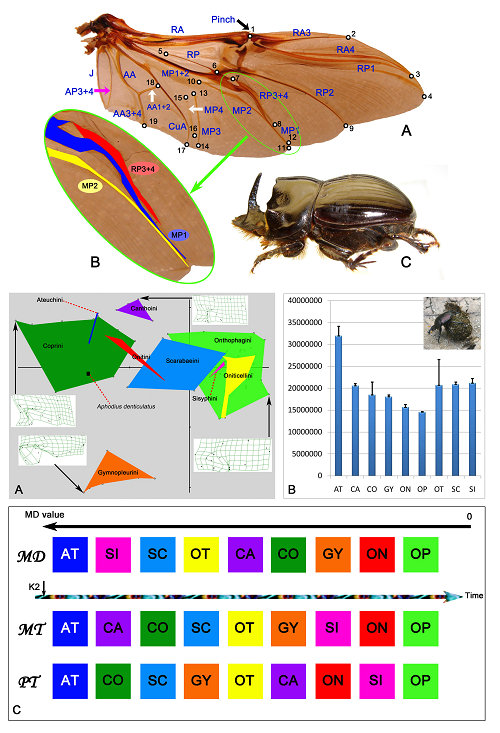The evolution of flight has led to a wide variety of morphological adaptations in such flying animals as birds, bats, and insects. Studying the evolution of flight characters is important to understanding the different selective external forces that have shaped the size and shape of wings and other flight traits, and how these adaptations may be limited by developmental or phylogenetic constraints. Wing venation, folding patterns, and other wing characters have long been recognized as important in taxonomic and phylogenetic analyses. However, if wing characters are suitable for the phylogenetic analyses and how wing characters have evolved over time are largely unexplored.
This study examines the morphological variation of hindwings based on 19 landmarks, 119 morphological characters, and 81 beetle species. There was a strong correlation between the morphometric tree and all phylogenetic trees (r>0.5). Reconstructions of the ancestral wing forms suggest that Scarabaeinae hindwing morphology has not changed substantially over time, but the morphological changes that do occur are focused at the base of the wing. These results suggest that flight has been important since the origin of Scarabaeinae, and that variation in hindwing morphology has been limited by functional constraints. Comparison of metric disparity values and relative evolutionary sequences among Scarabaeinae tribes suggest that the primitive dung beetles had relatively diverse hindwing morphologies, while advanced dung beetles have relatively similar wing morphologies. By integrating morphometric and cladistic approaches, this paper sheds new light on the evolution of dung beetle hind wings.
The results of this work were recently published in PLoS ONE. This research was supported by the Knowledge Innovation Program of Chinese Academy of Sciences, the National Natural Science Foundation of China, the National Basic Research Program of China (973 Program).
Internet access: Bai M, McCullough E, Song KQ, Liu WG, Yang XK (2011) Evolutionary Constraints in Hind Wing Shape in Chinese Dung Beetles (Coleoptera: Scarabaeinae). PLoS ONE 6(6): e21600
http://dx.plos.org/10.1371/journal.pone.0021600

